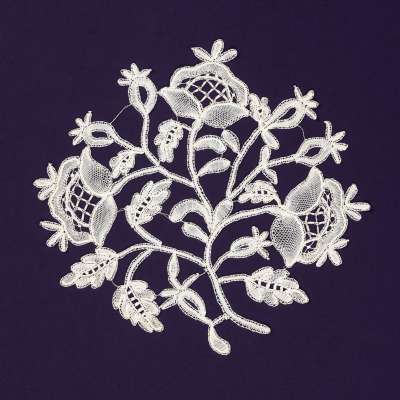Honiton (East Devon) lace sprig
Said to have been made as part of a commission for Queen Victoria in 1861, this East Devon bobbin lace sprig is part of a collection of British and Continental lace put together by Charlotte Treadwin, an important lace manufacturer with a business based in the Cathedral Yard, Exeter. The collection was donated to the museum in the late 1860s for lace-makers and designers to study. Treadwin once stated that there was not a single lace-designer in the whole of Devon, and strove to improve this, employing an artist to draw out her designs, and studying samples to better inform her practice and experimentation with lace-making patterns and techniques. By 1868, the lace manufactory and showrooms were already based at 5 Cathedral Yard (now known as the Cathedral Close).
The business had already been granted the royal warrant from Queen Victoria in 1848, before Charlotte’s marriage to John Treadwin. This sprig is part of a group of samples designed and made by Treadwin’s workshop for lace commissioned by the Queen.
Lace makers originally used flax, which made linen thread. Strong cotton thread became available in the 1830s. Much of this cotton had been grown by enslaved people. The American Civil War brought slavery in the Southern states to an end in 1868. This cotton lace sprig was made around 1861.
The business had already been granted the royal warrant from Queen Victoria in 1848, before Charlotte’s marriage to John Treadwin. This sprig is part of a group of samples designed and made by Treadwin’s workshop for lace commissioned by the Queen.
Lace makers originally used flax, which made linen thread. Strong cotton thread became available in the 1830s. Much of this cotton had been grown by enslaved people. The American Civil War brought slavery in the Southern states to an end in 1868. This cotton lace sprig was made around 1861.
Object Summary
- Accession Loan No.
- 29/2006/186
- Category
- Decorative Art
- Collection Class
- Textiles and equipment
- Common Name
- Honiton (East Devon) lace sprig
- Simple Name
- lace sprig
- Period Classification
- Victorian (1837-1901)
- Production Town
- Exeter
- Production County
- Devon
- Production Country
- United Kingdom: England
- Production Date
- 1861
- Production Person Initials
- Charlotte
- Production Person Surname
- Treadwin (nee Dobbs)


